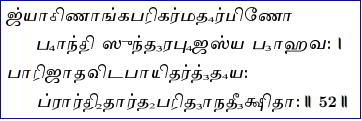- SlOkam 52:
- SlOkam 53:
- SlOkam 54:
jyAkiNAnka parikarma dharmiNa:
bhAnti sundarabhujasya bAhava: |
pArijAta viTapAyita rddhaya:
prArthitArtha paridAna dIkshitA: ||
Here the varNanam of the heroic shoulders continues.
Meaning:
His shoulders adorn the marks of the chord from His bow as He used His bow with both the hands as savyasAchi. The chord of the bow formed welts from usage (jyA kiNanka) and those welts appear like His AbharaNams for the shoulders (jyA kiNa anka parikarma dharmiNa:). One may wonder how can there be marks (welts) from the bow chord formed during Vibhava avatAram can be seen in the aprAkrta suddha sattvamaya tirumEni. Swamy Desikan answers it this way: “jyA kiNair-ankitatvam para vighraha bhujeshvapi tadabhedAnusandhAnena nirdiSati”. When one does not see any differentiation
(bhedam) between the two forms, one can see the welt marks in the body of the Para Vaasudevan as well according to Swamy Desikan.
Those shoulders are like the branches of the divine Kalpaka tree in displaying their generosity to those who seek the boons from Him: “karRpakak-kAvena naRpalat-tOLkaL” – TiruvAimozhi 6.6.6 (pArijAta viTapAyita rddhaya:). He is “koLLak-kuRaivilan vENDirRellAm tarum vaLLal maNivaNNan”. He grants all boons sought by His bhakthAs (prArthita artha paridAna dIkshitakaran). He grants with His four hands the four purushArthams (dharma, artha, kAma, moksham). Those celebrated hands known for their Vara PradAnam are resplendent (sundarabhujasya bAhava: bhAnti).
sAgara ambara tamAlakAnana
Syamala rddhaya udAra pIvarA: |
Seshabhoga paribhoga bhAgina:
tannibhA vanagirISitu: bhujA: ||
The eulogy of the four shoulders of SundarabAhu continues in this Slokam.
Meaning:
KUresar takes the cue from the pAsura vAkyams of PeriAzhvar, who visualized the Lord of TirumAlirumcOlai as being blessed with many sahasrams (thousands): Thousand-hooded AdiSeshan, thousand hills, thousand springs and thousand nandavanams(“Ayiram paintalaya anantasyananALum malai, AyiramARukaLum, sunaikaL palavAyiramum Ayiram pUmpozhilumuDai mAlirum cOlai atE” – PeriAzhvAr tirumozhi 4:3:10). KUresar salutes the bhujams of SundarabAhu which are matching the body of His bed, AdiSeshan, in length (Sesha bhoga paribhoga bhAgina: tannnibhA). His bhujams are fully rounded and stout (pIvarA:). They are very generous in granting boons (udArA:). They are broad (rddhaya:). Their hue is like that of the blue ocean and the sky (sAgara and ambhara) as well as that of the tamAla tree known for its darkish SyAmaLa color. Thus shine the bhujams of SundarabAhu, the Vana Giri nAthan (vanagirISitu: bhujA: bhAnti).
ahamahamikAbhAja: govardhana uddhrti narmaNi
pramathana vidhau abdhe: labdha prabandhasamakriyA: |
abimata bahUbhAvA: kAntA abhirambhaNa sambhrame
vanagiripate: bAhA: Sumbhanti sundaradorhare: ||
The eulogy of the sacred bhujams of SundarabAhu invokes the memory of those shoulders lifting Govardhana Giri, churning the Milky Ocean briskly and the eager embrace of His divine consort, MahA Lakshmi. Here, KUresar refers to the Lord’s desire to have more bhujams to hold and enjoy MahA Lakshmi in ekAntam (abhimata bahubhAvA: kAntA abhirambhaNa sambrame).
Meaning:
His bhujams were competing with one other in lifting the Govardhana Giri; they were engaged in the brisk act of churning the Milky Ocean to gain the wealth of MahA Lakshmi and embracing Her tightly thereafter and in that hurry wished there were more bhujams to consummate His bliss. The lifting of the Govardhana Giri was like a sport (govardhana uddhrti narmaNi) for the Lord and His many bhujams completed with one another (ahamahamikA bhAja) with the declaration of I want to be the first. These bhujams were engaged in the act of churning the Milky Ocean in an even manner (abdhe: pramathana vidhau labdha prabandha sama kriyA:).
Our Lord of Solaimalai embraced with ardour His divine consort, MahA Lakshmi with these four bhujams and wished at that time that he had more hands to hold and enjoy Her (kAntA abhirambhaNa sambhrame abhimata bahU bAhavA:).
Source:












